I2AO Part 5: Observing Planets of the Solar System
Back to the Index of I2AO (Introduction to Astronomy Online)
PART 5: OBSERVING PLANETS by Lesa Moore
- Orbits, the Ecliptic Plane and finding the Planets
- Orbital Aspects - Inner Planets
- Phases - Inner Planets
- Orbital Aspects - Outer Planets
- Phases - Outer Planets
- Observing Mercury
- Observing Venus
- Safely Observing Transits and the Sun
- Observing the Outer Planets
-----------------------------------------------------
1. Orbits, the Ecliptic Plane and finding the Planets
Planets of the Solar System orbit the Sun and they all travel at different speeds. Thus, they are not shown on a star chart, planisphere or atlas, because they are constantly moving with respect to the background stars. However, their orbits are inclined by only a few degrees to Earth's orbit, which lies on the Ecliptic plane. If you see a bright object that is not marked on your planisphere or chart, and it is near the Ecliptic, then it is most likely a planet.
Figure 1 below: The planets' orbits lie close to the plane of the Ecliptic.
Image Credit: http://cse.ssl.berkeley.edu/img/eclip.gif
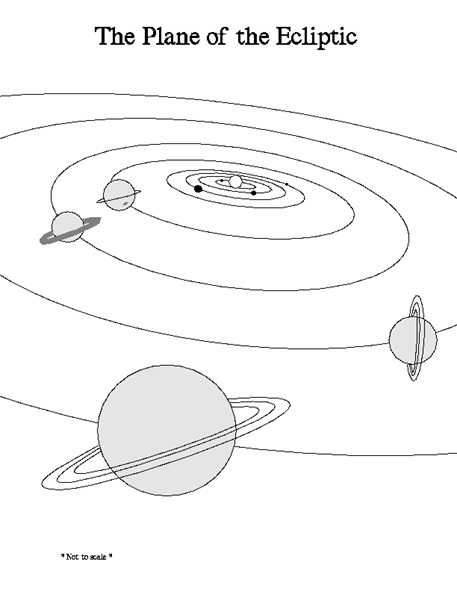
With the planetary orbits being close to the Ecliptic, this means that the planets will lie amongst the constellations of the Zodiac (and Ophiuchus).
Figure 2 below: A plan view of the Solar System shows why Saturn appeared in the constellation of Leo in 2008-2009.
Image Credit: http://www.areavoices.com/astrobob/images/Saturn_orbit_in_zodiac_1.jpg
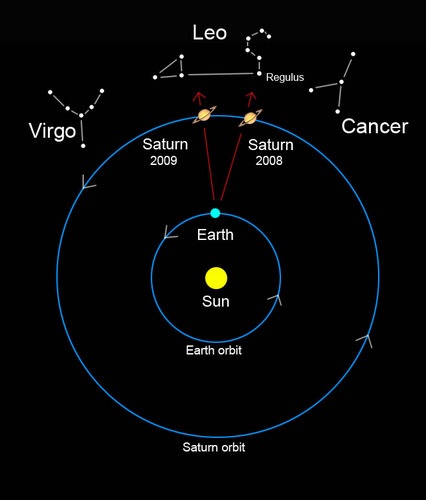
- Five planets are visible to the naked eye: Mercury, Venus, Mars, Jupiter and Saturn. Uranus and Neptune require at least binoculars to be seen, but they are more easily viewed with a telescope.
- Locating the current position of a planet may be achieved using software (e.g., the free program called Stellarium), or a chart from a yearbook. Astronomy 20XX from Quasar Publishing contains finder charts for Jupiter, Saturn, Uranus, Neptune and the minor planet, Pluto.
- Computer-controlled telescopes will have the planets in their databases and they can usually be selected quite easily. The telescope may be instructed to slew to the selection so that you can view the planet - this works as long as the telescope is set up and aligned correctly.
2. Orbital Aspects of the Inner Planets
- Mercury and Venus orbit closer to the Sun than the Earth does. Hence, they may be referred to as inner planets (or "inferior" planets).
- Mercury and Venus will never be visible overhead, nor in the opposite part of the sky to the Sun.
- As an inner planet orbits the Sun, remember that the Earth is in orbit too. Imagine that the two planets are running along slot-car tracks around the Sun and you are facing west. The inner planet, when first visible in the evening sky, is on the far side of the Sun. It is orbiting faster than the Earth so, even though we are moving around the Sun in the same direction as the other planet (towards the east), it is gaining on us. Night by night, it rises higher and higher in the sky, but still along the Ecliptic, which may be at some angle to the horizon.
- The point where an inner planet reaches its greatest angular distance from the Sun in the evening sky is known greatest eastern Elongation (because it is to the east of the Sun).
- From greatest eastern Elongation, the planet continues to race us and gets lower and lower as it catches up with Earth.
- During the evening apparition of the planet, the angular size of the planet's observable disc increases, as it is getting progressively closer to the Earth.
- Eventually, the planet crosses in between the Earth and the Sun. This point in its orbit is known as Inferior Conjunction. A conjunction is simply the close approach of two celestial bodies (technically, it is when they have the same right ascension or the same ecliptic longitude, as observed from Earth). Generally, the planet doesn't align exactly with the Sun, but is to one side or the other. If the planet does pass directly in front of the Sun, this is known as a transit.
- After Inferior Conjunction, the planet continues in its orbit towards greatest western Elongation and, then, back to the starting point, Superior Conjunction, when it is on the far side of the Sun. During this half of the orbit, the planet may only be viewed in the morning before sunrise.
Figure 3 below: Orbital Aspects of the Inner Planets. The diagram shows, in plan view, the relative positions of the inner planet (on the small circle) and the Earth (on the large circle). Position 1 is when the planet is an evening object seen in the west. Position 2 is Greatest Eastern Elongation, when it is highest in the evening sky. Position 3 is when the planet would be viewed as a morning object in the east.
Image Credit: Original diagram by Lesa Moore.
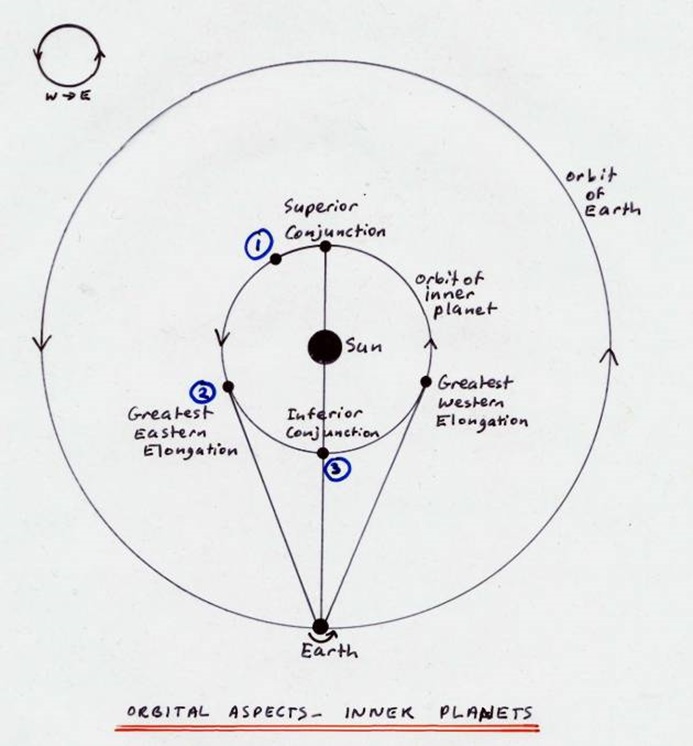
3. Phases of the Inner Planets
- Just as the Moon goes through phases in its monthly cycle, each planet also displays phases due to us being able to see different amounts of the sunlit side of the planet.
- After Superior Conjunction, when an inner planet is on the far side of the Sun, its phase is almost full, as the side that we observe is almost fully lit by the Sun. We can never see an inner planet fully lit because we are never in between the Sun and the planet.
- As the planet rises towards greatest eastern Elongation, the phase is gibbous (less than full, but more than half) and waning (becoming less illuminated) night by night.
- At greatest elongation, the planet is half lit.
- As the planet continues to approach, the Sun is now on the far side of it, so the phase of the planet moves to a crescent.
- The only time to observe a "new" phase of a planet is during a transit. Otherwise, the planet is too close to the Sun to be observable. It is also impossible or difficult for a period of days or weeks either side of conjunction (both inferior and superior).
- After Inferior Conjunction, the phase then waxes through the crescent, half and gibbous phases.
Figure 4 below: Phases of the inner planets. This example shows views of Venus in 2002.
Image Credit: TBGS Observatory, photo by Chris Proctor; http://venus.aeronomie.be/en/venus/phasesvenus.htm
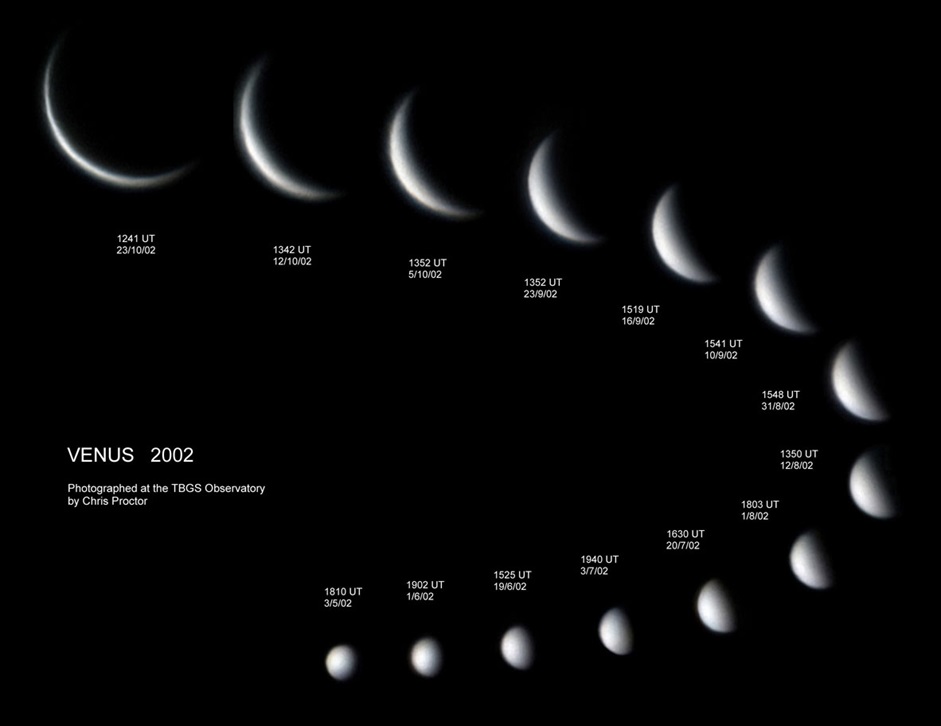
4. Orbital Aspects of the Outer Planets
- Mars, Jupiter, Saturn, Uranus and Neptune orbit farther from the Sun than the Earth does. Hence, they may be referred to as outer planets (or "superior" planets).
- It is possible to see outer planets overhead or in the opposite part of the sky to the Sun.
- In the slot-car track analogy, an outer planet is travelling more slowly than the Earth around the Sun. A good starting point is Opposition, when the planet is opposite the Sun in the evening sky. It will rise in the east at sunset and be visible all night, setting in the west at sunrise.
- After Opposition, night by night, the planet appears higher and higher in the sky at sunset, as the Earth races on ahead towards the east.
- Quadrature refers to the point where the planet and the Sun form a 90-degree angle at the Earth.
- As the planet moves away from opposition, its angular size is decreasing.
- Eventually, the planet passes the other side of the Sun. This point in its orbit is known as Conjunction.
- After Conjunction, the planet becomes a morning object, observable higher and higher at each sunrise, and increasing in angular size once again, as the Earth catches up with it.
Figure 5 below: Orbital Aspects of the Outer Planets. At Position 1, the planet is visible in the morning before sunrise. At Position 2, the planet is at Opposition, where it rises at sunset and appears largest in angular size than at any other point in its orbit. At Position 3, the planet is already above the horizon at sunset and moves progressively westward, night by night.
Image Credit: Original diagram by Lesa Moore.
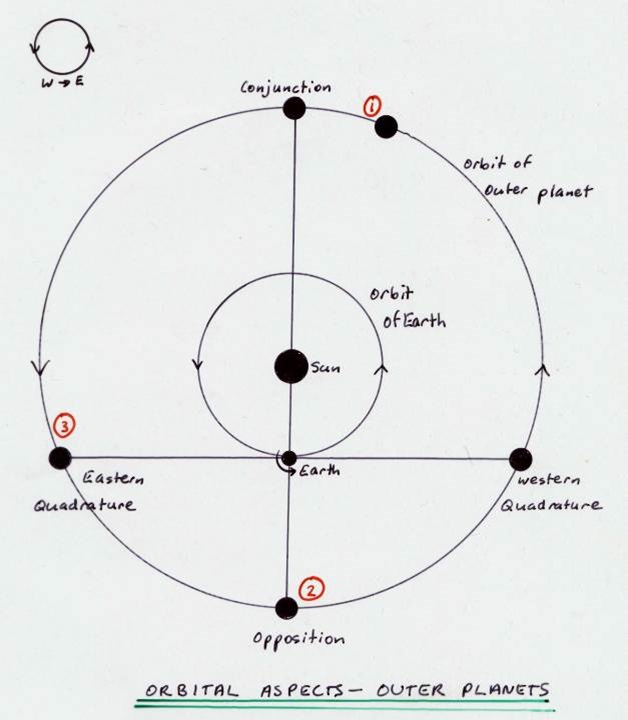
5. Phases of the Outer Planets
- Just like the inner planets, an outer planet appears smallest when it is on the far side of the Sun. Its phase appears gibbous, as, once again, we cannot see its full phase when it is on the far side of the Sun.
- The phase increases as the planet moves towards Opposition, when it will appear full.
- An outer planet is never seen as a crescent.
- Note that the diagrams here are not to scale and, in a scale view of the situation, the Earth is quite close to the Sun relative to the outer planet. Thus, the changes to the phase are rather subtle.
- The phase reverses after Opposition, with the planet becoming gibbous again.
Figure 6 below: Phases of the Outer Planets. This compilation of photos shows the changing phase and angular size of Mars during its orbit.
Image Credit: Niall MacNeill (ASNSW)
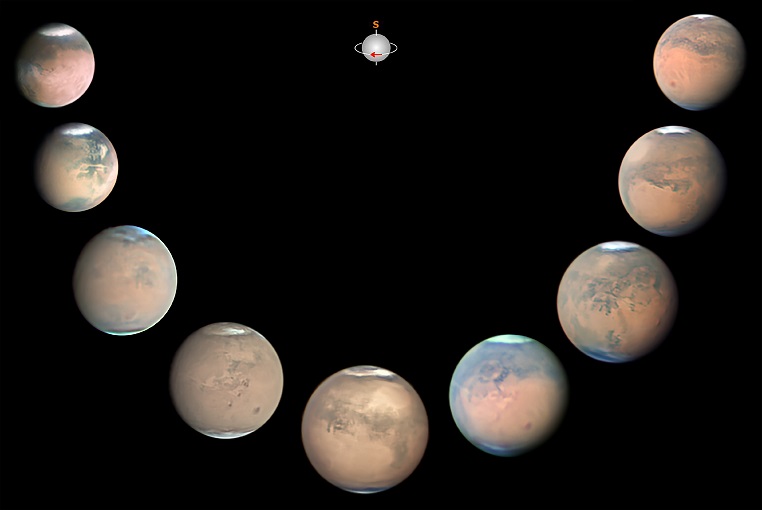
Mercury, the innermost planet, may never be seen farther than 28 degrees away from the Sun. It has been said that many famous astronomers never viewed Mercury because it is only visible in the twilight glow, either before sunrise or after sunset.
Thanks to Mercury's short 88-day orbit around the Sun, the planet reaches each of its greatest elongations three times per year. Mercury is visible to the naked eye, but using binoculars will help to pick it out in the twilight. However, care must be taken to avoid accidentally looking at the Sun. Wait until the Sun has fully set (or, if viewing in the morning, search before it has risen), or stand in the shade of a building if panning with binoculars to seek the innermost planet. The best opportunity to observe Mercury is when the combination of these effects is optimum:
- The Ecliptic makes a steep angle to the horizon;
- Mercury is at greatest Elongation;
- There is an unobstructed view to the horizon, with no cloud.
Mercury is visible to the naked eye. Through binoculars, its disc can be detected. A telescope will enhance the view and show the phase, though no surface detail will be resolvable.
Figure 7 below: Two views of Mercury through an amateur telescope.
Image Credit: Image by Elias Chasiotis, Greece (http://www.weasner.com/etx/guests/2005/guests_planets.html)
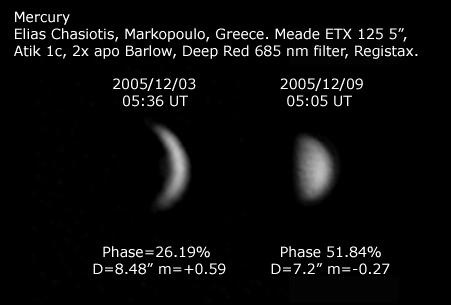
- Venus is the brightest object in the sky after the Sun, the Moon and the brightest appearance of the International Space Station.
- Venus spends eight months as the "evening star" and then eight months as the "morning star", though it is not a star at all.
- Venus, which orbits the Sun between Mercury and Earth's orbits, may venture as far as 47.8 degrees from the Sun.
- The planet is readily visible to the naked eye and may, at times, be seen in a fully dark sky. It is so bright that diffraction spikes are often seen associated with it. Diffractions spikes are optical effects caused by irregularities in the eye or a person's glasses. If you rotate your head, the diffractions spikes will also rotate.
- The phase may be detected through binoculars (easier with 10x power or more).
- Through a telescope, the phase will be obvious. However, Venus always appears pearly white, with no surface features, as only the top of the thick atmosphere can be seen.
- If you know exactly where to look (i.e., the right distance from the Sun in the right direction along the ecliptic), Venus is visible to the naked eye in the daytime. However, use EXTREME caution, especially if panning with binoculars, as eye damage will result if you view the Sun directly. Stand in the shadow of a building to ensure you don't accidentally sweep past the Sun in your search.
Figure 8 below: The Moon and Venus.
Image Credit: Photo by Lesa Moore.

8. Safely Observing Transits and the Sun
A Transit occurs when Mercury or Venus passes directly in front of the Sun. ANY observation of the Sun needs to be conducted with proper care, whether using filters or projection methods. Please note the following:
- NEVER look directly at the Sun.
- NEVER EVER look through an unfiltered instrument aimed at the Sun.
- It cannot be stressed enough that observing the Sun directly is dangerous and can cause permanent eye damage. In 2012, there were 70 reported cases of retinal burn in the UK from people who did not heed the warnings when viewing the Transit of Venus. Burns to the retina are painless and may take 4 to 48 hours to develop.
- Sunglasses are NOT safe to use for observing the Sun.
- Polarising filters are NOT safe to use for observing the Sun.
- Welding goggles ARE PROBABLY NOT SAFE for observing the Sun. They come in different grades, and only the darkest (No. 13) is usable as a solar filter. Even this is not recommended, however.
- ONLY observe the Sun with a solar filter designed specifically for observing the Sun.
An illustrated guide to safely observing Transits appeared in the June 2012 issue of Universe. It may be downloaded here. It was written for the Transit of Venus in 2012. Then next Transit of Venus will occur in 2117. However, all the same techniques apply for observing a Transit of Mercury. These always occur in May or November. A Transit of Mercury occurs in November 2019, but is not visible from Australia. The following Transits will be in November 2032 and November 2039. Both will be visible from Australia.
Figure 9 below: A safe way to observe a transit is by projection.
Image Credit: Photo taken by Geoff Sims at the 2004 Transit of Venus.
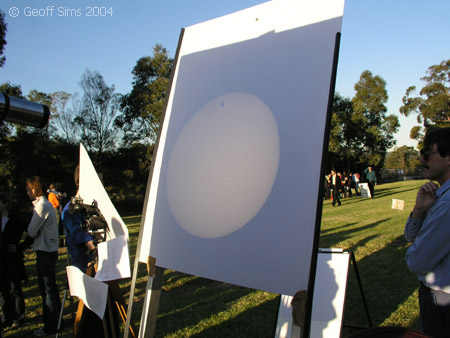
9. Observing the Outer Planets
Once you have determined the position of the planet you want to observe, use binoculars or a telescope to increase the size and see what detail is available. There is much information available for keen observers, so a VERY brief overview is included below.
- Mars is the only planet where you will see detail on the planet's surface. It displays polar caps, dark and light surface colours (in shades of red) and occasional dust storms (visible in the third and fourth images of Figure 6, above).
- Jupiter, the first of the gas giants, features belts and zones in its atmosphere. The equatorial belts are the most easily seen. The Great Red Spot, in the south equatorial belt, is a lingering storm cell that has been observed for hundreds of years. Also, readily visible are the four largest moons (Io, Europa, Ganymede and Callisto), discovered by Galileo in 1609. The moons appear in line with the planet's equator - refer Figure 10, below.
- Saturn is the one with the rings! The orientation of the rings changes, from Earth's perspective, during its orbit around the Sun - refer Figure 11, below. A small telescope will show at least one moon, Titan. A moderate-sized telescope will reveal another four or five moons - refer Figure 12, below. The most obvious details to note are the shadow of the rings on the planet, the shadow of the planet on the rings, the main Cassini division in the rings, and any visible features or bands in the planet's atmosphere.
- Uranus and Neptune are rather more challenging to observe. Uranus presents a modest, but discernible, disc in a telescope. Neptune will be more difficult to distinguish from a star.
Figure 10 below: Jupiter displays equatorial belts and three moons are visible to the right of the planet (click for larger image).
Image Credit: Photo from the Oxford Telescope, Tara Anglican School for Girls.
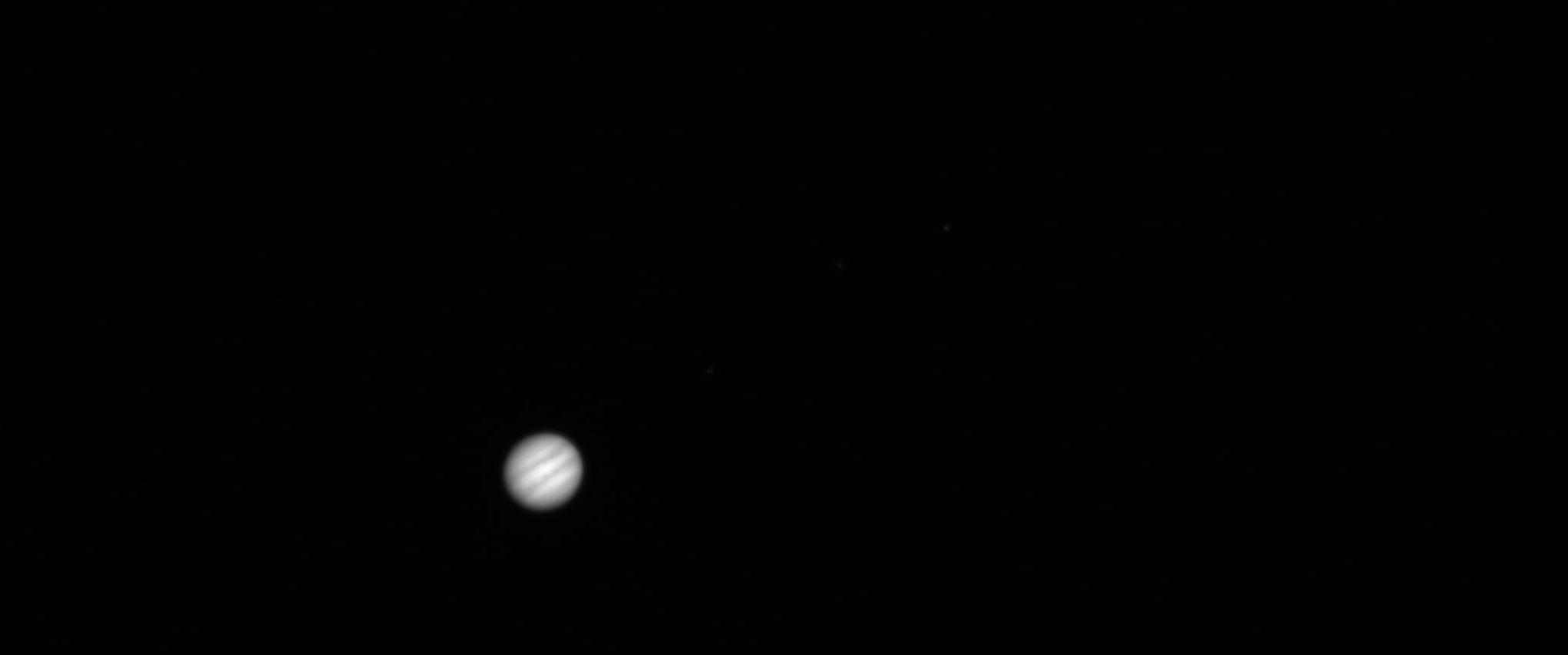
Figure 11 below: The changing orientation of Saturn's rings over a period of about seven-and-a-half years (one quarter of its orbit around the Sun).
Image Credit: NASA/Cassini Mission.
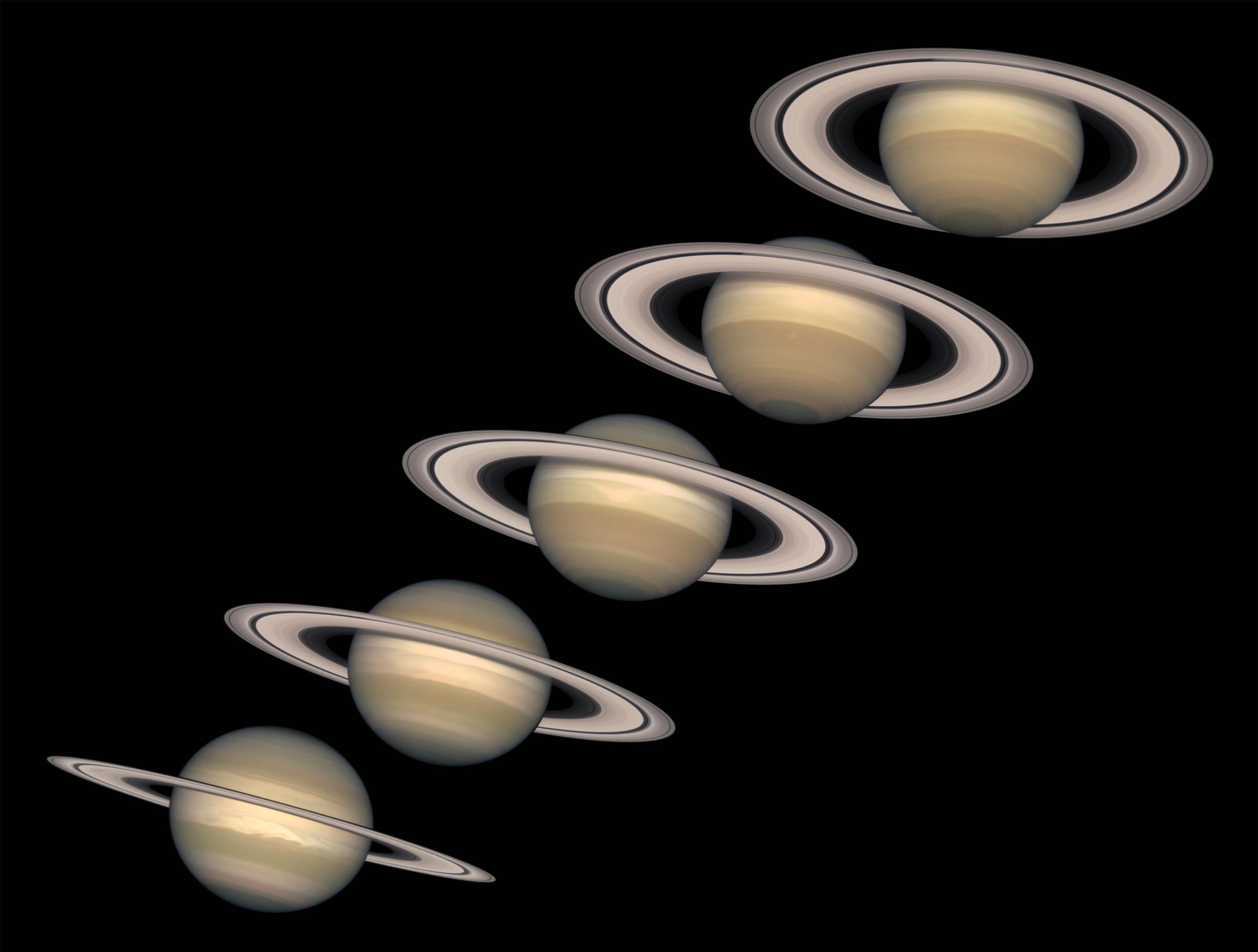
Figure 12 below: Saturn and bright moons, labelled.
Image Credit: Image by Pim Valk, The Netherlands (https://science.nasa.gov/science-news/science-at-nasa/2004/21apr_planets2).
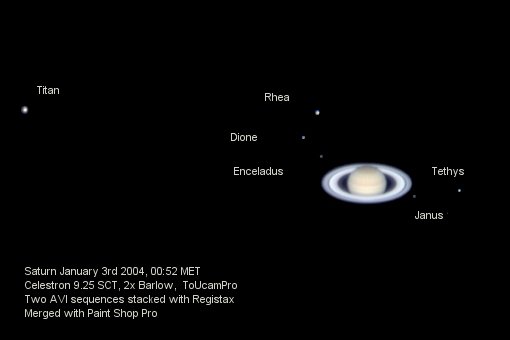
Author: Lesa Moore, 1st June 2019

